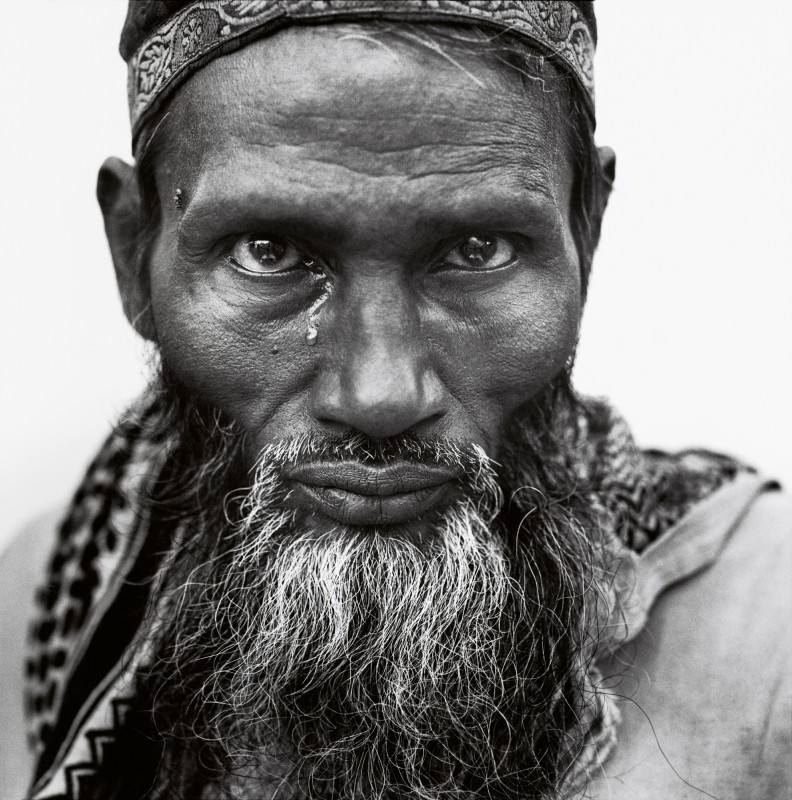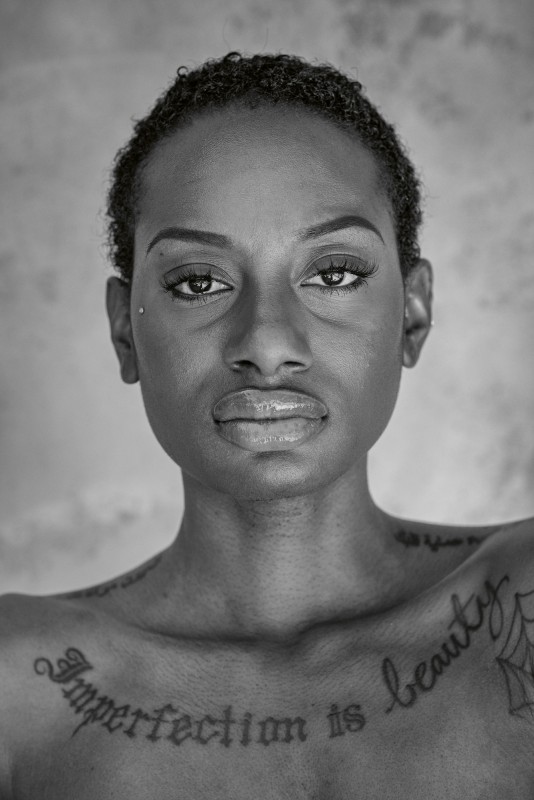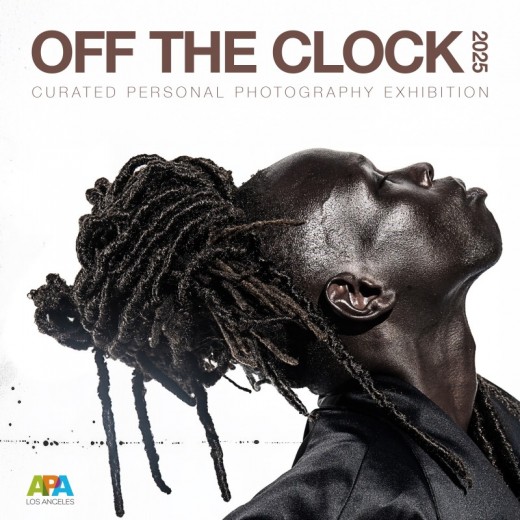
Winking Indian, Delhi, India ©Donald Graham
Donald Graham (APA LA member) finds authenticity and truth in making portraits of stories held in his subjects' faces. His new book One Of A Kind is a compilation of years of encountering others, unlike the polished studio portraits of celebrities and fashion models that launched his successful commercial photography career. Graham's black and white pictures celebrate his subjects' inner worlds, like the unexpected beauty of a disheveled man with torn clothing winking in India and a Muslim man with a tear. Graham's One Of A Kind series sets aside the notion of idealized beauty in search of the vulnerability of being human.

Muslim Man with a Tear, Delhi, India ©Donald Graham
What is it that draws you to a face – a stranger that you’d like to photograph? How do you approach that person?
DG: I am drawn to the stories told in a person’s face. What makes me stop and consider doing a photograph is always something about the person that touches my heart. When I have a camera in my hand, I always try to be in a highly sensitized place inside myself, so that everything I see can have the greatest possible emotional impact.
How I approach someone varies a lot, but the process must be organic. Often, it is as simple as walking up to a person and saying, “I’m a photographer. I find you very interesting. May I make some photographs with you?” I always try to communicate that I’m not “taking” a photograph, I want them involved in the making of the photograph.

Rastafarian Smoking Joint, Jamaica ©Donald Graham
How do you explain that you aren’t interested in making a picture of “beauty” but one of substance? How much art direction do you give in the photographing of the portraits?
DG: I think I do make photographs about beauty, it’s just a different perception of beauty. I’m not interested in an idealized, physical vision of beauty that feels unimaginative and inauthentic. I find beauty in courage, perseverance, dignity, and authenticity. I just have different values that I find beautiful.
In one photograph in “ONE OF A KIND”, “Janicia, Los Angeles, California”, the woman has tattooed under her collar bone, “Imperfection is beauty”. I love that.
My process of making the photograph is focused on the goal of authenticity and truthfulness. It’s not about posing. Usually, I’ll explain that I want them to be relaxed, honest and authentic. Sometimes, that’s enough and I can begin making photographs with little direction. Other times, I have to give a lot of direction. I might guide them into themselves by asking them to close their eyes and focus on their breath. When they open their eyes, they’re in a different place.

Janicia, Los Angeles, CA ©Donald Graham
Have you ever been turned down? Do your subjects like their portraits?
DG: Sometimes people don’t want to be photographed and that’s ok. Sometimes people don’t like the photographs I make and that’s ok.
Many of my photographs are different than the expectations of subjects, clients, PR agents, etc… because I don’t idealize people. When I’m asked if I can’t make the photographs a little more “aspirational”, I usually answer something like, “What I do best is authenticity. Try to appreciate the photograph because it’s truthful.”
Can you explain the shooting setup? Are you consistently using natural light? Are you setting up the backdrop on location or do you at times use a studio setting? How spontaneous are the images?
DG: My shooting set up is simple. I prefer a minimalist background, often white, and usually soft light. About half my photographs are in a studio and half outside. My process is about getting a person to slow down, discard habits, and be authentic. Sometimes that requires a lot of direction from me, sometimes almost none.
In ways, I am reminded of Richard Avedon’s In the American West series – the white backdrop, the way most subjects gaze into the camera. Did his work influence you?
DG: I have great respect for Richard Avedon, but this series began two years before he published “In the American West”. The choice to continue working on a white background almost exclusively may have been influenced by that book, but more importantly, I’ve always felt that what I do with a subject is quite different than what Avedon did. I think my photographs have an intimacy and a focus on one’s internal life. Avedon’s photographs are about something else.

Doroteo at 100 Years Old, Taos, NM ©Donald Graham
What do the One Of A Kind portraits say about you? What do you want the viewer to take away?
DG: I don’t know what these portraits say about me. I’ll let the viewer decide that. I simply want the viewer to experience what I experienced when I made the photograph. I want them to be touched by something they know is authentic because they feel that truth inside their self.
Can you discuss the difference in how you approach portraits of celebrities from the subjects in your book? Is there freedom in photographing people that aren’t famous?
DG: Anyone who is in front of the camera a lot is harder for me to photograph than someone who is not. Most people who have been photographed a lot have a previsualized picture of what they want the photograph to be and have rehearsed a routine to create it. In most cases, they want to appear confident, or powerful, or alluring, or joyous and they try to project that. That’s not what I do. So, I have to lead them away from their expectations to something more in the moment, authentic and new.
The portrait of your mother that began the One Of A Kind body of work is extremely compelling. She sits in the wheelchair with both dignity and grace. Can you talk about how you are careful not to exploit your subjects but to give them agency in the portrait?
DG: Respect is a guiding principle in my work and in my life. I think if you begin working with someone from a place of respect, things usually turn out pretty good for everyone.
I focus on the qualities I find exceptional in the person. When I photographed my mother, for example, dignity and grace were qualities that I was focused on. Hopefully, they are communicated as powerfully as I felt them.

My Mother, Seattle, WA ©Donald Graham
How does one edit thirty years of portraits into a book? What guided you in that process?
DG: I credit David and Nicholas Fahey, the renowned gallerists, for a lot of the edit. They reviewed hundreds of my photographs and made their selections and then we discussed the edit. We did probably four additional edits after the initial one.
My guiding vision in editing was focused on authenticity, truthfulness and the emotional reaction the photograph elicited.
What does the future hold for you in portrait photography? Will you continue to make images for One Of A Kind?
DG: In short, yes. I will continue to make photographs in the vein of ONE OF A KIND, as well as other projects. I love photography immensely. There are few things that give me greater satisfaction than the making of a photograph.

Image by ©Carsten Steinhausen
Email Donald directly to get a signed copy of the book, donald@donaldgraham.com



